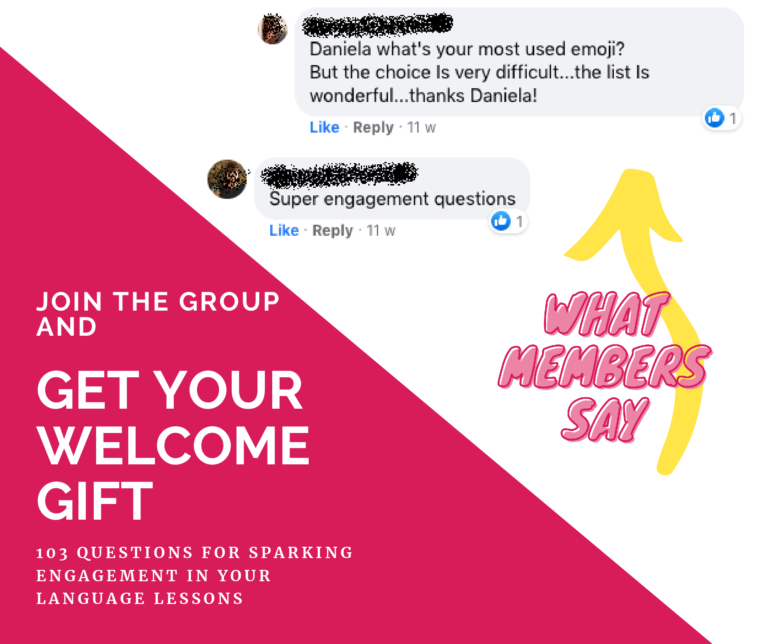
Many language teachers are familiar with using drama to teach English as well as other foreign languages. Nevertheless, some teachers get stuck or confused when it comes to planning a whole lesson based on drama. The goal of this article is to help to get clear on how to plan the perfect language by drama lesson, so that you can keep it as an example for your future lessons.
The questions I’m going to answer in this post are:
- What are the drama approaches for teaching foreign languages?
- What are the phases in a second language by drama lesson?
- How do we plan the perfect language by drama lesson?
- How do the drama approaches apply to each phase of a foreign language lesson?
- How long is each phase supposed to be?
Also, I’m going to show you an example for foreign language by drama lesson, so that you get a grid you can refer to every time you’ll delve into planning a second language by drama lesson!
Let’s get started.
1. What are the drama approaches for teaching foreign languages?
In the blog post The 7 types of drama exercises for teaching languages I wrote about the continuum of drama approaches that apply to foreign language teaching. Depending on the acquisition goals and the skills level of your students, you need to pick the approaches that suit better.
In that blog post I described each approach according to the pattern described by authors Kao and O’Neill. The blog post mentioned above in-depth describes those approaches, whilst in this article I’d like to look at the continuum in order to plan the perfect language by drama lesson.
The continuum of drama approaches for language teaching in brief
The authors classified the drama approaches for language teaching along a continuum. The continuum starts from the so-called closed/ controlled drama methods that give the students basic instructions, clear guidelines and ready-made texts/ dialogues/ scripts. The teachers play an important role because they need to facilitate the activities, to accompany the students through the exercises and to constantly assist the students in case of need. The acquisition experience focuses on the accuracy in the delivery of the tasks by the students. The most common closed/ controlled drama approaches are: scripted role-play, dramatised story, language games (grammar and vocabulary games).
The continuum goes on towards the semi-controlled drama methods (simulations and improvisational role-play), followed by the open communication drama methods (scenarios and Process Drama). According to the authors, the more we move towards the open-communication side of the continuum, the more the tasks aim at improving the students’ fluency. The teachers play a less central role in the exercises, the students are allowed to negotiate their roles as well as the communicative goals. All this aims at encouraging the students to get creative with the language, to put into use the new input and to getting involved in spontaneous communication.
2. What are the phases in a second language by drama lesson?
I’ll never stop repeating this over and over! Long Live the Acquisition Units! 😀 We looked at the phases in a language lesson as well as at how to structure an acquisition unit in the previous blog post How to plan the perfect language lesson. Briefly, that blog post explains how to structure a lesson by sticking to the acquisition unit structure. Within the acquisition unit parts, the core phases are: motivation, globality, analysis, synthesis.
“You don’t need to re-invent the wheel”
Now, a language through drama lesson stick to that pattern. In addition, we’ll need to pick the drama approaches that better suit each phase. Good news, right? You don’t need to re-invent the wheel: the steps we follow for planning a second language by drama lesson are exactly the same steps we would take for planning a not-drama-based language lesson.
Let’s look at the planning process, now. I’m going to walk you through a step-by-step process for using drama to teach English as a second language, as well as any other foreign language.
3. How do we plan the perfect language by drama lesson?
Here is a step-by-step process for planning your second language by drama lesson. The process I’m suggesting here is the long way. After developing some experience, you’ll be able to skip the first stage of the process and to jump to the second stage straight away.
Preliminary stage of planning
Firstly, set the goals for the lesson and decide on the content and the input you want to work on with your students.
First stage of planning
Secondly, choose not-drama-based activities according to the specific goals of each phase. Tap into your knowledge and toolbox and pick the activities and the exercises you are familiar with. The key task for you here is to get clear on the specific goals for each phase and, also, to figure out the types of activities and exercises you would choose according to the set goals for each phase.
- Acquisition unit phase: MOTIVATION
- Ask yourself…
- How can I trigger students’ interest towards the lesson topic?
- How can I help them to elicit and share what they already know about the topic?
- Example for not-drama exercise/ activity
- Conversation facilitated by the teacher. Use of open-ended questions for sparking engagement.*
- Group mind mapping facilitated by the teacher.
- Acquisition unit phase: GLOBALITY
- Ask yourself…
- How can I introduce the topic to the students for the first time?
- How can I help them to become familiar with the new input and to get to an overall, global understanding of the topic?
- Example for not-drama exercise/ activity
- Watching a video-clip where people talk about the topic (a dialogue, or an interview, for instance). Followed by: multiple choice questionnaire for consolidating the overall understanding of the material and for raising questions.
- Acquisition unit phase: ANALYSIS
- Ask yourself…
- How can I help the students to in-depth understand the new input?
- How can I help them to in-detail analyse the new chunks of information they need to understand and memorise?
- Example for not-drama exercise/ activity
- Grammar and/or vocabulary exercises. For instance: cloze exercise and verb conjugation grid.
- Acquisition unit phase: SYNTHESIS
- Ask yourself…
- How can I help the students to take the first step into putting into use the new input?
- How can I help them to put into use the new input in a creative way?
- Example for not-drama exercise/ activity
- Answering open questions. Creative writing related to the situation explored in the video-clip.
* Need inspiration? Download the list 103 questions for sparking engagement in the language classroom – find it inside the Facebook group Independent Language Teachers Collective:
Join Facebook Group & Get List
Now, let’s see together what happens when we transform the activities for using drama to teach English, Spanish, French, or any other language.
- Acquisition unit phase: MOTIVATION
- Example for not-drama exercise/ activity
- Conversation facilitated by the teacher. Use of open-ended questions for sparking engagement.*
- Group mind mapping facilitated by the teacher.
- …that turns into… Example for drama exercise/ activity
- Conversation and mind mapping. Afterwards: give the students different roles (they become characters in a story) and launch a shared experience exercise. This is a super effective and engaging group activity.**
- Acquisition unit phase: GLOBALITY
- Example for not-drama exercise/ activity
- Watching a video-clip where people talk about the topic (a dialogue, or an interview, for instance). Followed by: multiple choice questionnaire for consolidating the overall understanding of the material and for raising questions.
- …that turns into… Example for drama exercise/ activity
- Watching video-clip. The video-clip will be introduced as part of the story.
Afterwards: into small groups, quiz time! The characters (students) answer multiple choice questions.
- Watching video-clip. The video-clip will be introduced as part of the story.
- Acquisition unit phase: ANALYSIS
- Example for not-drama exercise/ activity
- Grammar and/or vocabulary exercises. For instance: cloze exercise and verb conjugation grid.
- …that turns into… Example for drama exercise/ activity
- In teams, grammar/ vocabulary game: cloze exercise and verb conjugation grid. To be completed within given time. AND/OR: Scripted role-play for revising and consolidating the new input.
- Acquisition unit phase: SYNTHESIS
- Example for not-drama exercise/ activity
- Answering open questions. Creative writing related to the situation explored in the video-clip.
- …that turns into… Example for drama exercise/ activity
- Storytelling with flash-cards presenting the new input. AND/OR: Improvisational role-play. Give some guidelines and ask to develop a story related to what they have seen in the video-clip. Discussion and brainstorming ideas for the improvisation, in small groups or in pairs. Guidelines could be about: a ‘what if…’ scenario, video script manipulation, etc.
* Need inspiration? Download the list 103 questions for sparking engagement in the language classroom – find it inside the Facebook group Independent Language Teachers Collective:
Join Facebook Group & Get List
** Don’t know what ‘shared experience’ is? Find out more about it in the Top 5 easy-easy-to-implement strategies for getting your students to speak and engaged guide:
4. How do the drama approaches apply to each phase of a second language lesson?
On one hand, the closed/ controlled drama approaches are usually a good fit for the analysis phase because there you want your students to solidify their detailed, in-depth understanding of the new chunks of information. Therefore, no creativity is needed: they need to focus on revising the input, analysing the meaning, reflecting on how the language works.
On the other hand, the semi-controlled as well as the open-communication approaches usually are a good fit for all the other phases of the acquisition unit.
According to the skills level of your students and the acquisition goals, you will make your choice about the drama methods.
Furthermore, remember you DON’T need to plan the entire lesson as a drama-based lesson. I mean, you could decide to propose a drama exercise within only one of the phases. For instance, going back to the example above, you might want to stick to not-drama methods except for the synthesis phase.
In LingoDrama English (Learn English through Drama) my teachers involve the students through the means of drama for, say, the 90% of the time. They deliver even the motivation and globality phases through drama, actually through activities specific for the LingoDrama training format. Is this something you are interested in, you can find out more here – CLICK HERE. The training format is perfect for those teachers interested in using drama to teach English as a foreign/ second language, even though it applies to any foreign language, really.
5. How long is each phase supposed to be if using drama to teach English /languages?
This really depends on your usual lessons schedule. Just remember: each phase of the acquisition unit can last a few minutes up to days. Hence, you might want to cover all the phases within a single lesson or to do that over multiple lessons over weeks.
Conclusions
The guidelines explained above are a gentle introduction to a huge topic such as lesson planning. My goal with those guidelines is to provide you with a clear example that might guide your next steps and help you to take action in planning language by drama lessons.
Before you go, allow me to remind you that if you are interested in using drama to teach English, there is loads of resources such as plays, scripts, dialogues, etc. that you can tap into for preparing your lessons. Reviewing these resources and sharing ideas about the activities we can do in the classroom is one of the topics I cover in the Facebook group Independent Language Teachers Collective.
Want more support?
Join the Facebook group Independent Language Teachers Collective to get daily advice, tons of free training and to branch out with other independent language teachers like you!
ALSO…
Available only for the Collective members: free list 103 question for sparking engagement in your language lessons.
This is what members say about the freebie:

Join in the Collective and grab your welcome gift:
Join Facebook Group

